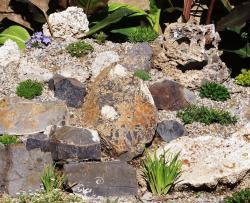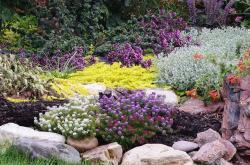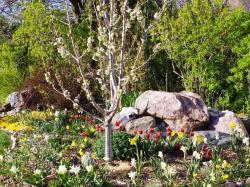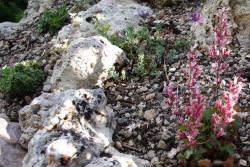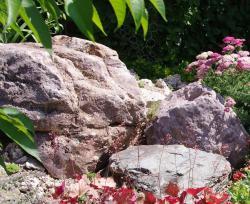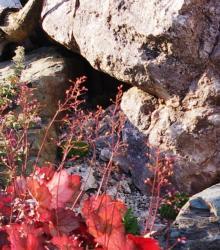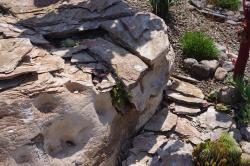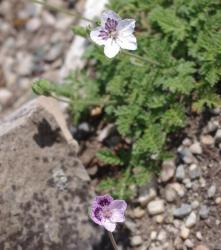dirtdorphins said:I'm gonna have to say that a lot depends on the plants that you wish to grow then and the all-rock substrate that you wish to use.
Sorry, having a little confusion replying here to Q's in the other thread as well--
Yes, of course, you can incorporate hypertufa into the design--if you can make it or get it--and plants can actually grow right in the real thing or the fake thing, but they will not grow right in field stone, for example. well, okay maybe some mosses, algae and lichens will, but I presumed that is not quite what you had in mind. Slate, in my experience, depends on how flaky it is really, but there the plants/roots are growing in the crevices between flakes not actually in the rock, or roots are behind the rock in the medium in the case of a dry-stack-wall. Some lava stones and some sand stones, with 'built in' crevices have worked pretty well for me with some weeds.
dirtdorphins said:looks like you want a little CA in IN--
I'll check back later because I've really got to go now
chelle said:
...mortar and rock wall... but I'm not too sure that I'll be fond of the non-natural form.
...slate, but...also using field rock and/or faux rock?
...a dry wall stack using slate for the height might be my best bet. If so, how deep does the earthworm gravel barrier need to be, or would I need it at all for a flat stack?
dirtdorphins said:
What rock material do you have available?
dirtdorphins said:
Is the mini-mountain for drainage or aesthetics or both?
dirtdorphins said:
How is your drainage? do I recall some seasonal flooding lake or something or am I getting people's places mixed up?
dirtdorphins said:
How's your humidity--some plants that flourish in lean summer-dry soil in arid environments will literally melt in high humidity. (for example, Stachys lavandulifolia, or so I have read. I don't know about IN, but I used to live in MN and recall miserably humid summers.
growitall said:
I wouldn't suggest a mortared rock wall unless you actually have a use for one. If the wall idea is just to create height, making it in a dry pack style would allow the wall itself to be planted though. But it sounds to me like what you really want is to create something that looks reasonably like a natural outcrop (unless I'm misinterpreting), so why not go for that?
I think a mix of rock type could certainly be made to look good; it would take more thought though.
I'm not familiar with the concept of an "earthworm barrier" so couldn't say.
I'll post some references on rock garden construction later...
growitall said:
It's sort of complicated (but fortunately, growing some desirable plants isn't) and I'm no expert, but it's probably safe to say that for most rock garden/alpine plants, it's really the soil conditions (primarily drainage) that are important, not the presence of rocks per se.
The wetter/more humid your climate, and the more prone it is to winter wet especially, the more important drainage becomes (hence the popularity in wet areas of alpine houses - the purpose of which is usually not insulation but primarily to shelter plants from too much water!)
As shown, sand beds and gravel beds can be great for growing plants that need good drainage and lean conditions - no rocks are required at all... in fact, to be honest, unless rocks are used skillfully, as in the incredible crevice beds I showed, they can actually reduce one's planting space quite a bit.... they take up a lot of room! However, the presence of rocks allows one to create structure and build up the garden (elevating it above the surrounding area improves drainage), and some rock garden/alpine plants do like to grow best with their roots in deep crevices between rocks. As you noted, rocks also allow one to create shade and shelter. And I suppose they help people to identify it as "a rock garden"... and I just like rocks, as many of you have said too!
The tufa is all natural, bought from Rocky Mountain Tufa whose quarry is in B.C.. The rocks were basically manhandled into place (we did it all ourselves with no machinery - DH had to move the biggest pieces from the first big order that were beyond my abilities; I avoided really big rocks in the second order!) The tufa rocks were mostly place on end for height. The main thing was the process of packing a lean soil mix in between the rocks, to stabilize them all and provide the growing medium and the fill in crevices. I'll post some photos of the process.
Keep in mind that I'm not saying this is the best or only way of doing it - it's only how I did it.
chelle said:
The Stachys lavandulifolia may have to reside on our south-facing, covered porch where there's a ceiling fan that can be used to stir the air. There's going to be a lot of trial and error going on, as I've never tried these types of plants here before.
dirtdorphins said:
Re: humidity
Air circulation is indispensable, but a ceiling fan stirring the air does nothing to decrease the relative humidity. Big difference between 20% and 80% no matter how much you move it around.
That being said--why not try it where you want it out in the open rather than a covered porch with a fan? Who knows--it might be just fine. Mine is not tiny, btw--it made a nice mat about 5"x16" as soon as it settled in
chelle said:Here's a starter list of what I'd like to try to grow in and around my future rock garden.
Campanula coriacea
Campanula rotundifolia
Keckiella cordifolia
Lewisia rediviva
Michauxia campanuloides
Mimulus cusickii
Mimulus aurantiacus
Mimulus palmeri
Minuartia laricifolia
Musineon tenuifolium
Nama rothrockii
Penstemon albidus
Penstemon cusickii
Pulsatilla vulgaris
Ramonda myconi
Rhodiola integrifolia
Stachys lavandulifolia
...and lots of others.

